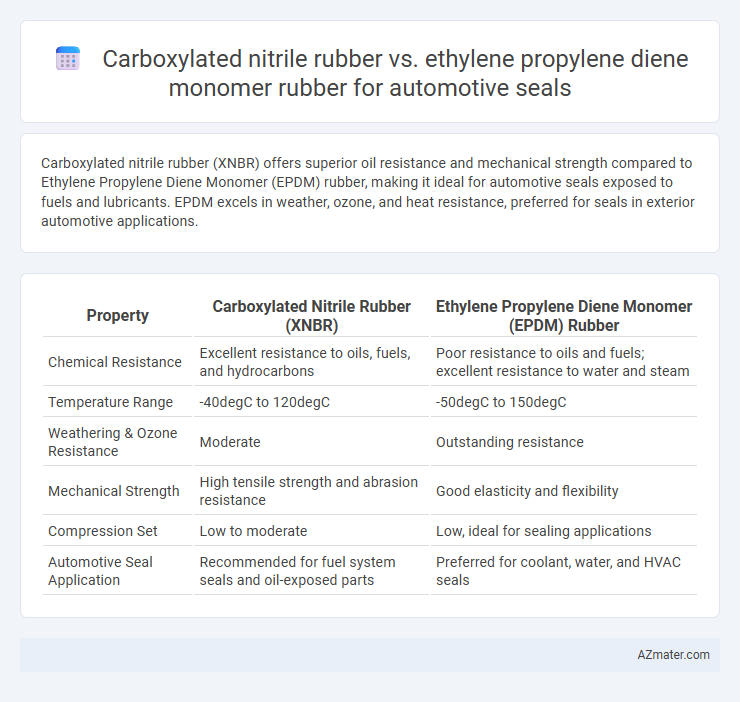Carboxylated nitrile rubber (XNBR) offers superior oil resistance and mechanical strength compared to Ethylene Propylene Diene Monomer (EPDM) rubber, making it ideal for automotive seals exposed to fuels and lubricants. EPDM excels in weather, ozone, and heat resistance, preferred for seals in exterior automotive applications.
Table of Comparison
| Property | Carboxylated Nitrile Rubber (XNBR) | Ethylene Propylene Diene Monomer (EPDM) Rubber |
|---|---|---|
| Chemical Resistance | Excellent resistance to oils, fuels, and hydrocarbons | Poor resistance to oils and fuels; excellent resistance to water and steam |
| Temperature Range | -40degC to 120degC | -50degC to 150degC |
| Weathering & Ozone Resistance | Moderate | Outstanding resistance |
| Mechanical Strength | High tensile strength and abrasion resistance | Good elasticity and flexibility |
| Compression Set | Low to moderate | Low, ideal for sealing applications |
| Automotive Seal Application | Recommended for fuel system seals and oil-exposed parts | Preferred for coolant, water, and HVAC seals |
Introduction to Automotive Seal Materials
Carboxylated nitrile rubber (XNBR) and Ethylene Propylene Diene Monomer (EPDM) are crucial materials in automotive seals due to their unique properties. XNBR excels in oil resistance, tensile strength, and abrasion resistance, making it ideal for seals exposed to fuels and lubricants. EPDM offers superior weather, ozone, and heat resistance, making it suitable for exterior seals exposed to harsh environmental conditions.
Chemical Structure Overview: XNBR vs EPDM
Carboxylated nitrile rubber (XNBR) features polar carboxyl groups attached to the nitrile polymer backbone, enhancing oil and fuel resistance while providing improved mechanical strength compared to standard nitrile rubber. In contrast, ethylene propylene diene monomer (EPDM) rubber consists of a saturated ethylene-propylene backbone with non-conjugated diene units, offering excellent weathering, ozone, and heat resistance but lower fuel resistance. The chemical structure of XNBR enables superior sealing performance in oil-exposed automotive environments, whereas EPDM excels in applications requiring resilience against environmental aging and high-temperature stability.
Key Performance Properties Comparison
Carboxylated nitrile rubber (XNBR) offers superior oil resistance and tensile strength compared to Ethylene Propylene Diene Monomer (EPDM) rubber, making it ideal for automotive seals exposed to fuels and lubricants. EPDM excels in weathering, ozone, and heat resistance, ensuring long-term durability in exterior automotive sealing applications. The choice between XNBR and EPDM depends on specific operational environments, with XNBR favored for fluid contact and EPDM preferred for environmental resistance.
Temperature Resistance in Automotive Seals
Carboxylated nitrile rubber (XNBR) offers superior temperature resistance compared to Ethylene Propylene Diene Monomer (EPDM) rubber, maintaining elasticity and sealing performance in temperatures ranging from -40degC to 120degC. EPDM excels in high-temperature resistance above 120degC, tolerating up to 150degC with excellent ozone and weather resistance but shows reduced effectiveness in low-temperature automotive seal applications. XNBR's enhanced resistance to heat aging and oil exposure makes it optimal for seals in engines and transmissions operating under thermal stress.
Chemical Resistance: Oils, Fuels, and Coolants
Carboxylated nitrile rubber (XNBR) exhibits superior chemical resistance to oils, fuels, and coolants compared to ethylene propylene diene monomer (EPDM) rubber, making it highly suitable for automotive seals exposed to petroleum-based fluids. XNBR's enhanced cross-linking structure provides excellent swelling resistance and durability in aggressive hydrocarbon environments. EPDM rubber, while resistant to heat and weathering, shows limited compatibility with oils and fuels, restricting its use in sealing applications involving direct contact with such chemicals.
Weathering and Ozone Resistance
Carboxylated nitrile rubber (XNBR) offers superior weathering and ozone resistance compared to Ethylene Propylene Diene Monomer (EPDM) rubber, making it more suitable for automotive seals exposed to harsh environmental conditions. XNBR's enhanced polar molecular structure allows it to maintain flexibility and resist cracking under prolonged UV and ozone exposure, while EPDM, though excellent for general weather resistance, may degrade faster in high ozone concentrations. This makes XNBR a preferred choice for automotive seals requiring long-term durability in aggressive outdoor environments.
Mechanical Strength and Wear Performance
Carboxylated nitrile rubber (XNBR) exhibits superior mechanical strength and excellent wear resistance compared to Ethylene Propylene Diene Monomer (EPDM) rubber, making XNBR ideal for automotive seals exposed to oils and fuels. EPDM offers good weather and ozone resistance but lacks the high tensile strength and abrasion resistance required for heavy-duty sealing applications. The enhanced cross-linking in XNBR provides increased durability and longer service life, especially in harsh automotive environments.
Cost Effectiveness and Manufacturing Considerations
Carboxylated nitrile rubber (XNBR) offers superior oil resistance and mechanical strength, making it cost-effective for automotive seals exposed to harsh fluids, while its curing process allows for faster production cycles compared to Ethylene Propylene Diene Monomer (EPDM) rubber. EPDM rubber excels in weather, ozone, and heat resistance, often resulting in higher upfront material costs but lower long-term maintenance expenses due to its durability in outdoor automotive applications. Manufacturing considerations for XNBR include compatibility with commonly used accelerators and curatives to optimize curing time, whereas EPDM processing demands precise temperature control and specialized curatives to maintain its elastomeric properties.
Typical Automotive Applications for XNBR and EPDM
Carboxylated nitrile rubber (XNBR) is extensively used in automotive seals requiring exceptional oil, fuel, and abrasion resistance due to its polar carboxyl groups enhancing chemical durability and mechanical strength. Ethylene propylene diene monomer (EPDM) rubber is preferred for weather-exposed seals, such as door and window gaskets, because of its superior resistance to ozone, UV radiation, and extreme temperature variations. Typical automotive applications for XNBR include fuel system components and oil seals, whereas EPDM excels in sealing applications in HVAC systems and exterior trim.
Choosing the Right Rubber for Specific Automotive Sealing Needs
Carboxylated nitrile rubber (XNBR) offers superior oil and fuel resistance, making it ideal for automotive seals exposed to harsh fluids and high temperatures. Ethylene propylene diene monomer (EPDM) rubber excels in weather, ozone, and heat resistance, suitable for exterior seals and those in contact with water or steam. Selecting XNBR or EPDM depends on the specific sealing environment, with XNBR preferred for hydrocarbon exposure and EPDM favored for durability against environmental degradation.

Infographic: Carboxylated nitrile rubber vs Ethylene propylene diene monomer rubber for Automotive seal
 azmater.com
azmater.com